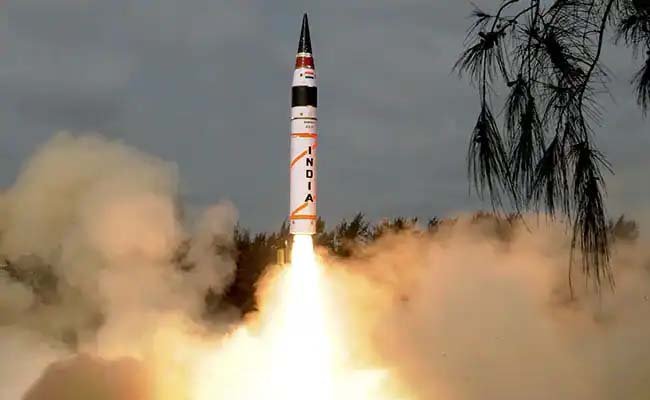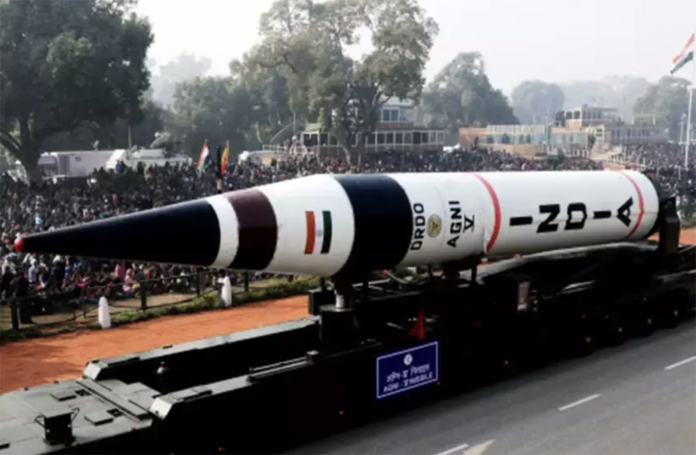Global Nuclear Power Play: The line between nuclear deterrence and conventional threshold is increasingly being revisited and becoming blurred in contemporary conflicts. In a world defined by VUCA (volatility, uncertainty, complexity and ambiguity) the strategic security equilibrium is being redefined by nations deploying both conventional and nuclear weapons in unison. In addition to wars increasingly being powered by proxy play, multi-domain operations are questioning and redefining the redlines resulting in nuclear power play. As the use of strategic nuclear weapons has dire consequences of massive response, the discourse is also shifting to Tactical Nuclear Weapons (TNW) to restore an adverse situation or strengthen operational deterrence.
The Ukraine conflict is gradually assuming more dangerous contours. The dual deployment of both conventional and nuclear delivery means has created new escalation dynamics. The West has steadily escalated the military confrontation in Ukraine by supplying the Ukrainian security forces with increasingly sophisticated weaponry to target Russians. This has been done progressively to question the Russian red lines. President Putin, however, has been warning the West, that Russia is a nuclear country and will retaliate with nukes if its existence is threatened. The nature of the response and its intensity remains ambiguous deterring the West.
There are also speculations of an underground nuclear test by Iran to deter a probable strong response from Israel after Iran fired 180 missiles at Israel. Iranian senior General Ahmad Haghtalab said that Iran might react by changing its nuclear policies if it was attacked by Israel. He said that such an attack could provoke Iranians to counterattack Israel’s nuclear reactors. It would also imply the nuclearisation of Iran and the Middle East.
The emerging global security canvas thus warrants India to revisit and review its nuclear doctrine and strategic deterrence capabilities to understand how a country balances deterrence and diplomacy in an increasingly dynamic world with escalating threats.
Genesis of India’s Nuclear Doctrine
India commenced its nuclear programme early but did not test its nuclear capability until 1974, through a test codenamed ‘Smiling Buddha’. However, India only weaponised its nuclear capability in the late 1990s. It was only when India conducted a series of nuclear tests in 1998 that there was a shifting strategic vector and a necessity for a formalised nuclear doctrine. The doctrine outlined in 1999 but adopted in 2003 has been guided by three core tenets.
- No First Use (NFU): The doctrine stipulates, on the one hand, ‘non-use of nuclear weapons against non-nuclear weapon states’ and on the other hand, says that nuclear weapons will only be used in retaliation against a nuclear attack on the Indian Territory or Indian Forces ‘anywhere’.
- Credible Minimum Deterrence: India maintains a nuclear stockpile that can credibly deter adversaries without engaging in an arms race. The stockpile is sufficient to address its threats with the desired capabilities and outcomes.
- Massive Retaliation: If attacked with nuclear weapons, India will resort to ‘massive retaliation’. India does not make a distinction between tactical or strategic strikes and any nuclear weapon use will escalate quickly to a strategic level. Any nuclear attack on India would trigger a massive retaliatory strike, inflicting unacceptable damage on the aggressor.
These principles represent India’s nuclear weapons posture and resultant posture as based on deterrence rather than war-fighting, and the approach is mature, restrained yet firm and resolute.
No First Use: Cornerstone of Responsible Nuclear Policy
India’s ‘No First Use’ (NFU) based nuclear doctrine marks a critical constituent of its strategic security construct and the symbol of its international identity. The doctrine was evolved to testify to India’s responsible nuclear behaviour while ensuring credible deterrence.
The most distinctive feature of India’s nuclear doctrine is the requirement for NFU, which highlights India’s stance regarding the fundamental use of nuclear weapons being one of deterrence against, rather than war-fighting. It is reflective of the broader strategic culture of India, an emphasis on restraint, diplomacy, and the use of force as a last resort.
NFU policy has significant strategic and ethical implications for India. Strategically, India assumes the responsibility of being a responsible nuclear power with an armada of nuclear weapons in the hope of minimising the risk of nuclear confrontation. NFU reduces incentives for an arms race, particularly in unstable regions like South Asia. NFU is a reflection of India’s traditional advocacy for nuclear disarmament and non-proliferation consistent with its leadership in global disarmament forums.
Credible Minimum Deterrence and NFU
While NFU doctrine reflects restraint, it does not mean India is not prepared or capable. The principle of ‘Credible Minimum Deterrence’ guarantees that India maintains a nuclear arsenal strong enough to cause out-of-proportion damage in retaliation deterrence to any potential adversary. This dynamic doctrine adjusts to the security environment, technological advancement, and strategic imperatives.
India’s nuclear triad has land-based ballistic missiles, air-delivered nuclear weapons, and submarine-launched missiles. The triad ensures survivability and retaliation even in the event of one or more components being compromised. The induction of INS Arihant (India’s first nuclear-powered ballistic missile submarine, SSBN) followed by the induction of INS Arighat marks significant milestones in providing a credible second-strike capability. However, there remains a void for a nuclear-powered attack submarine (SSN) fleet, which has now been addressed by the government nod for constructing two SSN boats, the apex predators in undersea warfare.
The Ukraine conflict is gradually assuming more dangerous contours. The dual deployment of conventional and nuclear delivery means has created new escalation dynamics. The West has steadily escalated the military confrontation in Ukraine by supplying the Ukrainian security forces with increasingly sophisticated weaponry to target Russians
Lessons from Contemporary Wars: Ukraine and Iran-Israel Standoff
The Ukraine-Russia and Iran-Israel conflicts with nuclear signalling mandate a revisit by India of its nuclear doctrine and capabilities. The strategic relevance of nuclear deterrence against a superior conventional force remains primary. Ukraine was made a pawn by giving up on its nuclear weapons (back to the USSR on independence), which lowered its strategic deterrence. Ukraine decided to denuclearise completely, in exchange, it was to get a security guarantee from the US, the UK and Russia, known as the Budapest Memorandum. The void of this strategic deterrence played against Ukraine. Russia’s nuclear brinkmanship and posturing allowed its forces to carry out full-fledged conventional operations under a strategic umbrella, wherein NATO has not been able to directly intervene.
Similarly, the Iran-Israel standoff dynamics after Iran’s missile attack and the nuclear response debate is another important lesson. The nuclear brinkmanship following Iran’s unparalleled missile strikes shows how a country could demonstrate both deterrence, conventional as well as nuclear simultaneously. Israel’s retaliatory strikes not yet precipitating a nuclear showdown are testaments to the thin line between deterrence and diplomacy.
For India, confronted with nuclear-armed adversaries Pakistan and China, there is a critical need to analyse how missile defence impacts delivery mechanisms and the plausibility of second-strike capability. India should analyse such areas wherein emerging technologies could challenge its command and control systems cum targeting capabilities and thus potentially affect its nuclear deterrence posture. It must also be prepared for contemporary conflicts with the dual posturing of conventional and nuclear assets. After all, the defeat mechanism primarily lies in targeting the mind of the adversary.

Regional Complexities: China and Pakistan
India’s nuclear doctrine has essentially been designed to deter two nuclear-armed antagonists: Pakistan and China. While both challenge India’s strategic posture their flavour and capabilities vary.
Pakistan: Islamabad’s development of tactical nuclear weapons, along with its first-use nuclear posture as part of its full spectrum deterrence, complicates India’s scale of conventional response. Both in Kargil and Balakot, these TNWs contributed to operational deterrence and limiting conflict escalation. Tactical nuclear weapons are considered battlefield assets in adverse conditions; they could create debate on the doctrine of ‘massive retaliation’ as a strategic response. Pakistan uses these as operational deterrence against India to deter and limit India’s conventional military superiority. In turn, with ‘massive retaliation’ as the guiding principle in its response, India deters even the limited use of nuclear arms. As a stated policy, India does not differentiate between tactical or strategic nuclear weapons in its response strategy. However, lessons from the recent conflicts compel India to reassess the credibility of this threat given the evolving technologies and missile defence systems to dilute its application. Further, the aspect of global pressures of massive retaliation in response to a tactical strike needs to be integrated into India’s strategic response mechanism.
There are speculations of an underground nuclear test by Iran to deter a probable strong response from Israel. Iran’s General Ahmad Haghtalab said Iran might react by changing its nuclear policies if attacked by Israel because such an attack could provoke Iranians to counterattack Israel’s nuclear reactors. It would also imply the nuclearisation of Iran and the Middle East
China: Beijing follows an unconditional NFU policy, implying discreetly to use of TNW under adverse conditions of red lines being violated, hinting possibly Taiwan. It aims to modernise its nuclear arsenal and increase its nuclear ambiguity through conventional nuclear entanglement. Several unknowns complicate Chinese strategic force numbers, official data on its nuclear forces and stringency controls. It reflects doctrinally deterrence, coercion and ambiguity as its construct. Chinese military strategists expressed views by threatening nuclear use in a conventional conflict under certain conditions through the so-called ‘lower the nuclear coercion threshold’ operation.
The asymmetry in the nuclear capability between India and China and the resulting differential calls for India to focus on adding teeth and credibility to its second-strike capability. This poses a strategic challenge to India, as China has modernised its armed forces rapidly, with missile technology and sophisticated nuclear delivery systems. The need is for a multi-layered exo-atmospheric and endo-atmospheric missile defence shield against both conventional and nuclear strikes by China. India also needs to enhance both its reach and strike capability and address the present imbalance through both technology upgradation and advanced multi-mode dispersed delivery mechanisms. India must modernise its nuclear delivery systems, and cyber weapons and enhance its space-based surveillance and ABM (Anti-Ballistic Missile) defence for strategic stability vis-à-vis China. India needs to improve its triad nuclear posture, upgrade arsenals, review doctrines, optimise new technologies like MIRV and hypersonic systems for precision targeting and develop full spectrum capabilities with diverse nuclear warheads for any contingencies. A review of ASAT systems dovetailed in its deterrence matrix is also warranted.
Diplomacy and Deterrence: A Delicate Balance
India’s nuclear doctrine is an articulated form of deterrence but at the same time, an instrument of diplomacy. India has successfully exercised its nuclear posture in the context of maximising strategic autonomy, controlling regional security dynamics, and asserting itself at the forums of disarmament on the international stage.
India has been a vocal international proponent of nuclear disarmament and, at the same time, eager to join the leading non-proliferation regimes, such as the Nuclear Suppliers Group (NSG). India did not join the Nuclear Non-Proliferation Treaty (NPT) because it was perceived as biased and discriminatory. India adheres to non-proliferation principles and adheres to export control regimes, thereby further establishing India’s credentials as a responsible nuclear state.
Challenges to the Doctrine and Debates over NFU
Despite the strengths, India’s nuclear doctrine is facing a challenge in an increasingly dynamic global security environment. New technologies — hypersonic weapons, cyber warfare, and missile defence systems — could compromise the credibility of India’s deterrence. Hypersonic missiles travelling at speeds more than five times the sound barrier could compress decision-making time during a nuclear crisis. Also, cyber-attacks on command and control systems may impair India’s ability to respond to an attack, further complicating its dilemma in a deterrence strategy.
For India, confronted with nuclear-armed China and Pakistan, there is a need to analyse how missile defence impacts delivery mechanisms and the plausibility of second-strike capability. India should analyse the areas wherein emerging technologies could challenge its command and control systems cum targeting capabilities and thus, affect its nuclear deterrence posture
There has also been a debate within India’s strategic community over the relevance of NFU under the present security paradigm. It has been argued that Pakistan and China’s developed nuclear postures and technologies seem to call for a review of this NFU policy. The present NFU reviewed could provide India with greater strategic flexibility, a package more amenable to a conditional NFU policy. Ardent advocates of NFU are quick to suggest that stability takes precedence and that one should not be rash to jettison a policy that lifts India’s moral standing and increases the deterrence against the realisation of a nuclear arms race.
Yet a certain ambiguity such as the threat of use being taken as first use would add teeth to the NFU. Nuclear doctrines get played more in the cognitive domain and ambiguity adds to the deterrence. Thus information warfare in the nuclear domain adds to the perceptions, which contribute to deterrence. The debate within the strategic community for options in keeping with changing dynamics must thus find space.
Conclusion
India’s doctrine, based on the principles of No First Use, Credible Minimum Deterrence, and Massive Retaliation, reflects a carefully calibrated approach to balance deterrence and diplomacy. It will continue to be characterised by challenges and, therefore, India’s nuclear posture will have to be constantly aligned to evolving technologies and shifting adversarial strategies.
Drawing lessons from contemporary conflicts, from the Russia-Ukraine war to the Iran-Israel missile standoff, India must strengthen its strategic deterrence and capabilities for greater stability. While India is trying to navigate the complex security challenges, its nuclear doctrine is vital in its unstated national security strategy providing it with strategic stability and global respect. Yet the NFU doctrine must be periodically visited to balance credible deterrence, diplomacy and emerging threats.
The author, a PVSM, AVSM, VSM has had an illustrious career spanning nearly four decades. A distinguished Armoured Corps officer, he has served in various prestigious staff and command appointments including Commander Independent Armoured Brigade, ADG PP, GOC Armoured Division and GOC Strike 1. The officer retired as DG Mechanised Forces in December 2017 during which he was the architect to initiate process for reintroduction of Light Tank and Chairman on the study on C5ISR for Indian Army. Subsequently he was Consultant MoD/OFB from 2018 to 2020. He is also a reputed defence analyst, a motivational speaker and prolific writer on matters of military, defence technology and national security. The views expressed are personal and do not necessarily carry the views of Raksha Anirveda

















